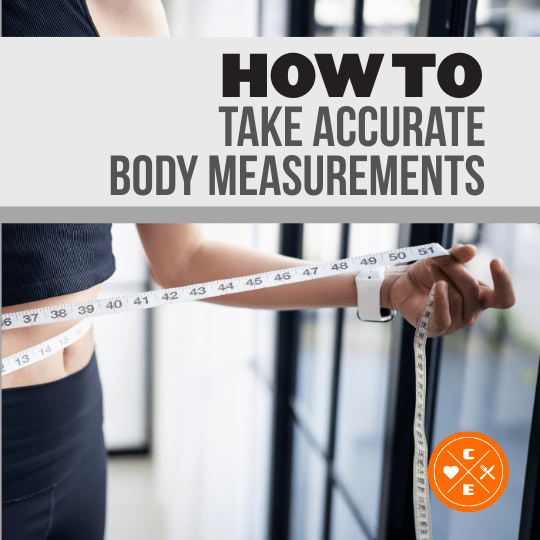How to Take Accurate Body Measurements

Jason Nista
Healthy Lifestyle
05/05/2025 8:08am
9 minute read
Table of Contents
Want to track your fitness progress effectively? Start measuring your body instead of relying on the scale. Here's why and how to do it:
Why Measurements Work Better Than Weight:
- Show changes in fat loss or muscle gain.
- Track specific areas like arms, waist, or hips.
- Stay motivated even if your weight doesn’t change.
Tools You’ll Need:
- Flexible measuring tape (fabric, not metal).
- Full-length mirror for accuracy.
- Notebook or app to log results.
How to Measure Key Body Parts:
- Arms: Measure the midpoint between shoulder and elbow.
- Chest: Wrap tape across the fullest part.
- Waist: Find your natural waistline and measure after exhaling.
- Hips: Measure the widest part of your buttocks.
- Thighs: Wrap tape around the top, near the hip.
Best Practices:
- Measure in the morning before eating.
- Wear form-fitting clothes or measure in underwear.
- Log results every 2-4 weeks.
Consistency is key. Regular measurements, paired with a healthy lifestyle, help you see real progress over time.
Required Tools and Setup
Tools You Need
To take precise body measurements, you'll need a few simple items:
- Flexible measuring tape: Use a fabric tape measure, usually 60 inches long, as it easily conforms to body curves. Avoid metal tape measures since they don't bend well around the body.
- Full-length mirror: A mirror that shows your entire body helps ensure proper tape placement and posture.
- Measurement log: This can be a notebook or a digital spreadsheet. Make sure it includes columns for the date and the body parts you're tracking.
Optional extras:
- A body measurement tracking app
- A digital scale for weight tracking
- A pen or marker to mark measurement points
With these tools, you'll be set up for accurate and consistent measurements.
Measurement Setup
Create the right environment and prepare yourself to ensure consistent results:
Clothing Tips: Wear form-fitting clothing, such as compression shorts or a sports bra, or measure in your underwear. Avoid bulky clothes and remove your shoes.
Environment Preparation:
- Stand on a flat, well-lit surface, approximately 6 inches away from a full-length mirror.
- Keep the measuring tape parallel to the floor for horizontal measurements.
- For vertical measurements, ensure the tape is straight up and down.
Body Position: Stand with your feet together, shoulders relaxed and back, and look straight ahead. Maintain natural breathing to keep your measurements neutral.
For consistency, take your measurements at the same time each day - ideally in the morning before eating. This reduces variations caused by water retention or meals.
How To Accurately & Consistently Take Your Measurements
How to Measure Each Body Part
Here’s a step-by-step guide to help you take accurate and consistent body measurements.
Measuring Arms
Stand upright with your arm relaxed at your side. Find the midpoint between your shoulder and elbow - this is where your bicep is at its peak. Wrap the measuring tape around your arm at this spot, making sure it’s snug but not too tight. Repeat the process on both arms, even if you’re primarily tracking one side. Record the measurement in inches, rounding to the nearest 0.25".
If you’re measuring yourself, bend your arm slightly to hold the tape in place, then relax before taking the final measurement.
Next up: your chest.
Measuring Chest
Stand straight with your arms slightly raised:
- Women: Position the tape at the fullest part of your bust, typically across the nipple line.
- Men: Wrap the tape around your chest at nipple level, keeping it level under your armpits.
Take the measurement while breathing normally.
Now, let’s measure your waist.
Measuring Waist
Find your natural waistline, which is the midpoint between your hip bones and rib cage. Stand relaxed with your feet hip-width apart. Wrap the tape around your waist, keeping it parallel to the floor. Take the measurement after a normal exhale. The tape should fit snugly but not press into your skin.
Let’s move on to your hips.
Measuring Hips
Stand with your feet together and locate the widest part of your buttocks. Wrap the tape around this area, ensuring it passes over both hip bones and the fullest part. Keep the tape level and parallel to the floor from front to back. Distribute your weight evenly on both feet.
Finally, let’s measure your thighs.
Measuring Thighs
Stand with your feet slightly apart for stability. Find the fullest part of your thigh, typically near the top where it connects to your hip. Wrap the tape horizontally around this point, keeping it perpendicular to your leg.
To ensure consistency, mark the measurement point with a washable marker or note a specific anatomical landmark.
sbb-itb-1989a25
Best Practices for Tracking Progress
When to Measure
Take measurements every morning before eating or drinking anything. Stick to the same day each week to ensure consistency in your tracking.
Tracking Your Results
Once you've set a regular schedule, log your measurements to keep track of your progress. You can use a notebook, a spreadsheet, or a fitness app - whatever works best for you.
Here’s a simple framework to follow:
- Write down the date, time, and measurements for each body part.
- Take progress photos to compare visually over time.
- Check and record measurements every 2-4 weeks.
Here’s a quick guide for how often to measure and take photos based on your goals:
| Progress Stage | Measurement Frequency | Photo Frequency |
|---|---|---|
| Starting Out | Every 2 weeks | Every 2 weeks |
| Maintenance | Every 4 weeks | Monthly |
| Active Changes | Every 2 weeks | Every 2 weeks |
Be sure to note anything that might influence your results - like changes in your exercise routine, diet, sleep patterns, or stress levels.
Many fitness apps now offer tools for tracking body measurements and even include visual graphs to help you spot trends over time. These can make it easier to stay on top of your progress and adjust as needed.
Next Steps for Success
Combine precise measurements with a balanced approach to nutrition and exercise to see progress more effectively.
Set SMART goals based on your measurements. For example, you could aim to trim 1 inch off your waist in 8 weeks by sticking to regular workouts and managing portion sizes.
Portion Control Made Simple: Accurate measurements help guide your eating habits, and Clean Eatz Kitchen makes it easier with their portion-controlled meals. As they explain:
Our business is built around helping people live healthier lifestyles. All of our food comes in portion-controlled, balanced servings that will make eating healthier easier for you. [1]
Track Progress from Different Angles: Pair your measurements with other key indicators to get a full picture of your progress:
| Progress Indicator | Tracking Frequency | Why It Matters |
|---|---|---|
| Body Measurements | Every 2-4 weeks | See physical changes clearly |
| Progress Photos | Bi-weekly | Capture visual milestones |
| Energy Levels | Daily | Gauge overall well-being |
| Strength/Endurance | Weekly | Measure fitness growth |
These tools work together to reinforce the importance of steady routines.
Consistency is the key to long-term results. One Clean Eatz Kitchen customer shared their experience:
Clean Eatz Kitchen has supported my weight loss journey and helped instill great habits – I've lost over 20lb this year and always enjoy their menu of delicious, convenient, and well-priced options. [1]
Stick to healthy habits, and your body measurements will reflect the effort and commitment you put into your lifestyle changes.
FAQs
How can I take consistent and accurate body measurements to track my fitness progress?
To ensure your body measurements are consistent and accurate, follow these simple tips:
- Use the same tools: Always use a flexible measuring tape designed for body measurements. Avoid using rigid tapes or tools not meant for this purpose.
- Measure at the same time: Take your measurements at the same time of day, ideally in the morning before eating or exercising, to minimize fluctuations.
- Wear minimal clothing: For accuracy, wear fitted clothing or measure over bare skin.
- Consistent positioning: Stand up straight, relax your muscles, and avoid sucking in your stomach. Use a mirror to ensure the tape is level and not twisted.
Key areas to measure include your waist, hips, arms, chest, and thighs. Write down your measurements and track them over time to monitor progress. If you're looking for convenient, healthy meal options to support your fitness journey, consider Clean Eatz Kitchen. Their portion-controlled, chef-prepared meals can help you stay on track with your goals.
What are the most common mistakes to avoid when measuring your body for fitness tracking?
When measuring your body for fitness tracking, accuracy is key. Here are some common mistakes to avoid:
- Using inconsistent tools: Always use the same tape measure to ensure consistent results.
- Measuring over clothing: This can add extra inches to your measurements. Measure directly on your skin for the most accurate numbers.
- Incorrect placement of the tape measure: Make sure the tape is snug but not too tight, and always keep it parallel to the ground for areas like the waist and hips.
- Not standing properly: Stand up straight and relaxed when measuring, avoiding any slouching or tensing of muscles.
- Measuring at different times of day: Your body can fluctuate throughout the day, so try to measure at the same time each time you track.
By avoiding these mistakes, you’ll get more reliable measurements and a clearer picture of your fitness progress.
How do body measurements relate to other signs of fitness progress, like energy levels and strength improvements?
Body measurements are just one piece of the puzzle when tracking fitness progress. While they help you monitor changes in areas like your waist, hips, and arms, they don’t tell the whole story. Increased energy levels, improved strength, and better endurance are also key indicators of progress that may not always show up in measurements.
For a well-rounded view of your fitness journey, combine regular body measurements with other markers like how much weight you can lift, how you feel during workouts, and your overall energy throughout the day. Together, these factors provide a clearer picture of your health and fitness improvements.
Related Articles
How Buying in Bulk Saves Money on Meal Prep
10 minute read
Top 7 Apps for Nutrition & Fitness Tracking (2025)
4 minute read
10 Tips for Low-Sodium Dining Out
12 minute read


